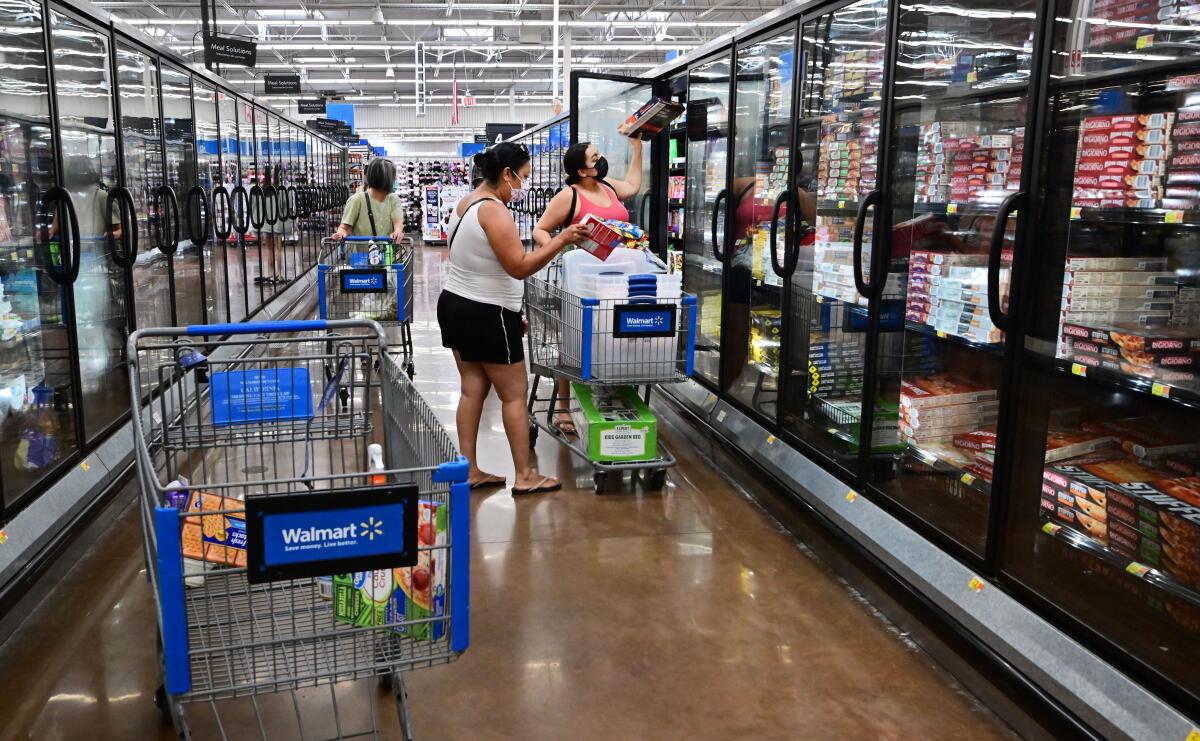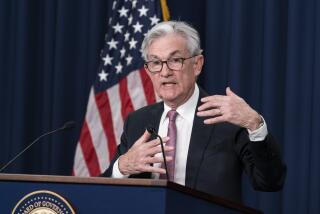Rising prices set to gobble up Americans’ Thanksgiving budgets

WASHINGTON — That turkey you’re planning for the big family get-together is going to give you a nasty peck on the pocketbook. So will the flour for the gravy and the butter for the rolls.
The latest government report on consumer prices, released Thursday, showed poultry prices are up a whopping 17% from a year ago. Flour is up 24%. Butter and margarine are up 32%.
The pain did not stop with the traditional holiday menu. Almost across the board, inflation showed few signs of slacking. And in areas central to most consumers’ everyday lives, prices are rising at faster rates than many Americans have seen in their lifetimes.
The results could include a recession, changes in consumers’ spending patterns and standards of living, and political upheavals in next month’s pivotal national elections.
“It’s pretty insane,” said Laura Shouse, a small-business owner in Huntington Beach, referring to soaring prices, especially of the organic, grass-fed foods that she buys.
Shouse’s answer for this Thanksgiving: Buy a smaller bird than usual, have more family and friends bring side dishes, and pick a little more from her “booster garden during these times.”
The most immediate result of the new price report is that the Federal Reserve is now almost certain to give interest rates another boost, perhaps even going beyond the three-quarter-percentage-point increases it has announced for the last several months.
U.S. stocks initially tumbled on the inflation news, then surged, ending the day sharply higher after one of the biggest market swings in years. Analysts were stunned by the huge reversal, with some speculating that perhaps the report wasn’t as bad as it appeared or that the market was already down too much.
“I think it simply got too cheap,” said Christopher Rupkey, chief economist at Fwdbonds in New York.
For consumers, however, it was hard to see a silver lining. Higher interest rates, for example, will push new car prices still higher, increase the cost of buying a house and further lift already-soaring rents on houses and apartments.
Adding to the blow, consumers who stashed away substantial nest eggs during the COVID-19 lockdowns have drawn down those savings — which means overall spending power is likely to shrink.
Continued inflation is also eating into the wage gains many Americans have made. A recession would add to the problem, with more layoffs and less hiring.
Just when the experts thought inflation might be cooling as gas costs have come down from their summer highs, the latest numbers show it’s still raging across the economy.
The annual inflation rate, at 8.2% in September, was just a notch below August and stayed near a four-decade high, the government said Thursday. And so-called core inflation, which excludes volatile food and energy items, hit a new 40-year high last month.
Now, an issue that many people could all but ignore in the recent past is turning into something that’s hurting them in just about every corner of their personal lives.
Thursday’s report showed pockets of relief for consumers. Prices of clothes, appliances and used cars actually declined over the month.
But there’s been no letup in the sticker shock for new cars and trucks, which had been fueled by a shortage of the computer chips that today’s cars can’t run without.
New vehicle prices are up 19% from two years ago. And to add insult to injury, consumers’ auto insurance costs surged last month, joining the double-digit inflation club.
Moreover, people may be reluctant to travel over the holidays as gas prices, after falling from more than $5 a gallon nationally in June, have been creeping higher and are now back to nearly $4. In California, regular gas on Thursday averaged a whopping $6.20 a gallon.
The cost for medical care rose sharply last month, and so did veterinary services. Transportation services rose as repair shops raised their prices and airfares went up further.
These higher costs are squeezing many more people, some of whom are tapping their credit cards and home equity lines to make up the difference between their paychecks and rising prices.
In September, the average hourly wages for all private-sector employees were up 4.9% from a year earlier, well short of the year-over-year change in prices.
For retirees, the September inflation numbers brought separate, welcome news that Social Security recipients will see an 8.7% bump in benefits next year, the biggest increase in more than 40 years.
The Social Security Administration’s annual cost-of-living adjustment is based on the government’s consumer price index in the prior year’s third quarter.
This year, the increase was 5.9%, although higher Medicare premiums ate up some of those gains.
The upcoming raise should provide some relief to the 70 million Social Security beneficiaries.
“I’m looking forward to it,” said Tom Stapleton, a retired workplace training consultant who lives in Glendale.
People dependent on the federal government’s retirement or supplemental income programs have been hit especially hard by soaring prices for necessities such as food.
“Our folks think that will quickly be offset by the rise in cost of living, so at best, stabilizing,” said Renée Ward, founder of Seniors4Hire.org, an Orange County-based organization that helps older workers nationwide find employment. Still, she said of the step-up in Social Security payments, “That’s a good thing, all things considered…. At least it won’t drive us further back.”
Americans may express their unhappiness over inflation at the polls next month.
The unsettled economy has been a primary reason for President Biden’s low approval rating. And with control of Congress at stake in the midterm election, Republicans have seized on what has been the biggest economic issue for policymakers, business leaders and consumers.
Washington’s emergency pandemic programs, approved during the Trump and Biden administrations, turbocharged spending. That boosted demand for goods even as manufacturing and delivery problems limited supplies, which helped fuel inflation.
Supply chain bottlenecks have since eased, but with the reopening of the economy and the still-sizable amount of excess savings, American consumers are getting out more and spending on travel, eating out and other services. And many businesses have been able to pass on their higher costs for supplies, labor and other expenses to customers.
That has also helped keep job growth robust. Employers in September created 263,000 additional jobs, about three times more than what’s needed to keep pace with the workforce population growth. The unemployment rate last month matched a half-century low of 3.5%.
Up to now, layoffs have been mostly limited to tech firms and sectors such as real estate and finance, which are always highly sensitive to changes in interest rates. In the rest of the economy, most businesses have been reluctant to let employees go, given the tight supply of workers and the still-solid demand from consumers.
Nonetheless, the hot labor market and broader economy may be cooling given the higher interest rates, the threat of ever-rising oil prices and the war in Ukraine, which are slowing trade and adding to uncertainty.
The Fed wants both job growth and overall economic growth to slow down enough to drive inflation back to its 2% target, and the central bank is planning to keep raising interest rates until it gets the results it wants, even at the risk of causing a recession.
For now, most economists are still hopeful that the U.S. will avoid a serious downturn, thanks to the still-solid labor market and relatively healthy financial condition of most households.
“At this time, I believe the worst-case scenario is a mild recession,” said Bernard Baumohl, chief global economist at the Economic Outlook Group in Princeton, N.J.
At least some business owners would agree, among them Daniel Swenson-Klatt.
A former middle school teacher turned entrepreneur, the 60-year-old has been running Butter Bakery Cafe in Minneapolis for the last 17 years. Like many other shops, his breakfast and sandwich place has benefited from the reopening of the economy. And in August, Swenson-Klatt felt like things were going back to the pre-pandemic days. He started getting orders again from a neighborhood theater for cookies and treats served during intermission. “Wow, maybe we’re back,” he thought to himself.
But September was a whole different story. He saw fewer customers, and more of them were being cautious. Moreover, he had to close his cafe on Saturdays during the entire month because he didn’t have enough cooks. He pays his employees $16.25 an hour to start.
His costs for materials and supplies were up 15% to 20% from a year ago and have nearly doubled for paper goods such as bags and cups, prompting Butter Bakery to add a packaging charge for customers.
Still, Swenson-Klatt doesn’t sense that his customers are bracing for a deep recession. Nor is he panicking.
“It’s been a crazy period coming out of the pandemic,” he said, “and we’re all trying to find that normal again.”
More to Read
Get the L.A. Times Politics newsletter
Deeply reported insights into legislation, politics and policy from Sacramento, Washington and beyond. In your inbox three times per week.
You may occasionally receive promotional content from the Los Angeles Times.











